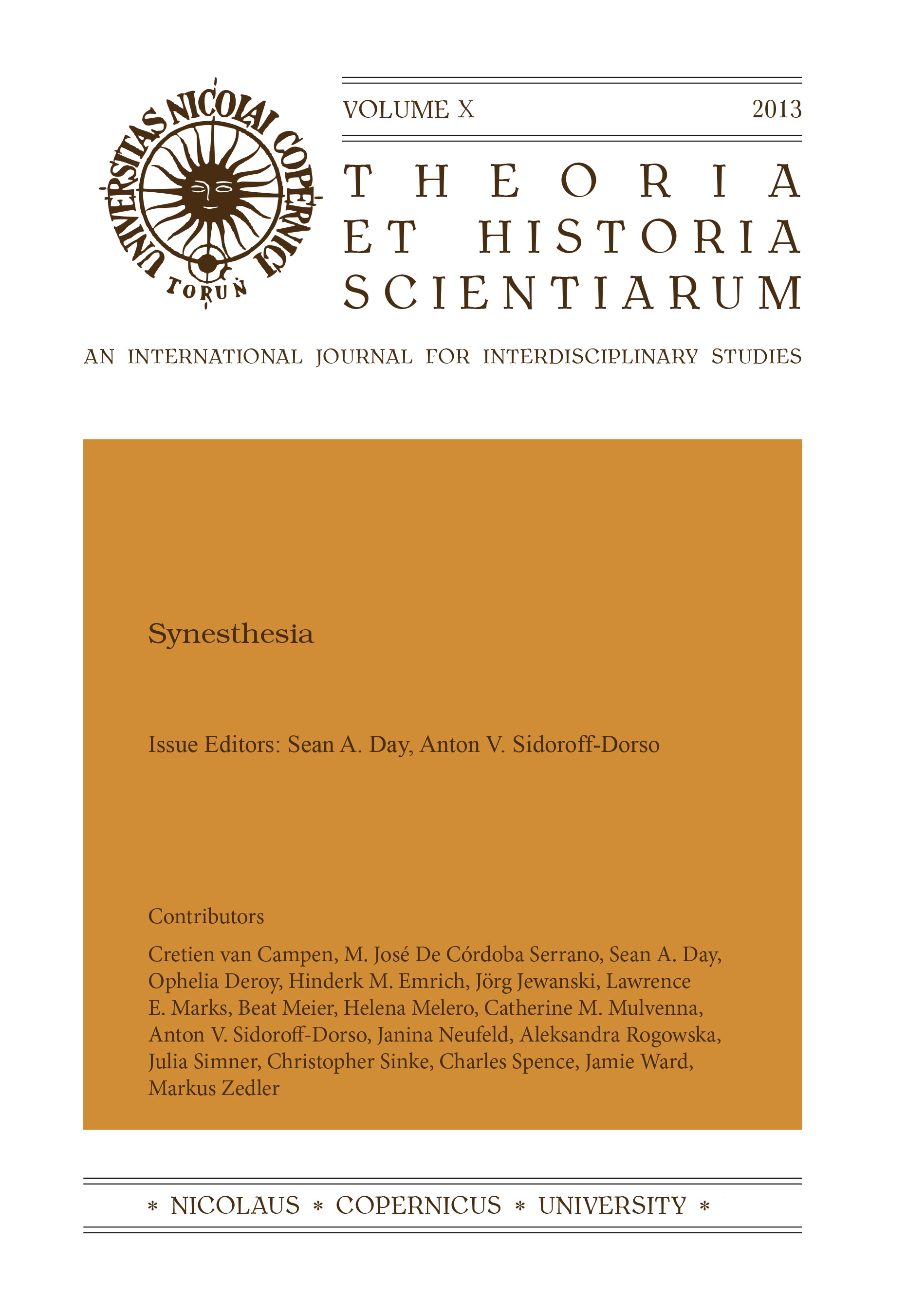Why study synesthesia? What can that teach us about ourselves?
DOI:
https://doi.org/10.12775/ths-2013-0009Keywords
synaesthesia, ideaesthesia, survey, applied methodologies, art education, multi-modal thinking, sensory representationsAbstract
This essay describes the results of the author’s projects of studying synaesthesia in Spain (University of Granada). It outlines several surveys of potential synaesthetes and possible relations of synaesthesia, creativity and types of “sensory representation”/ intelligence. The author provides her own original definition of “natural synaesthesia” as multi-modal thinking actualized through diffuse perception and polyphonic attention. Such an understanding emphasises the importance of constant philosophical reconsideration of synaesthesia and an interdisciplinary approach to researching the phenomenon. One of the major conclusions made in this essay is that synaesthesia is embedded in the multiple and multilevel processes of the unconscious that constitute both thinking and creativity. Which in turn might mean that perception could be explained through synesthesia and not the other way around, with subsequent revision of the theories of cognitive processes in psychology and neurosciences. The described results lay the foundations for the author’s synaesthesia-based applied methodologies in art education that are aimed to raise awareness of unusual perception among potential synaesthetes and enhance holistic creative thinking of the students through the multi-sensory aspects that they can further include into their own projects.
References
Asher, Julian E., Michael R. F. Aitken, Nasr Farooqi, Sameer Kurmani and Simon Baron-Cohen. 2006. “Diagnosing and phenotyping visual synaesthesia: a preliminary evaluation of the revised test of genuineness (TOG-R).” Cortex 42.2: 137–146.
Asher, Julian E., Janine A. Lamb, Denise Brocklebank, Jean-Baptiste Cazier, Elena Maestrini, Laura Addis, Mallika Sen, Simon Baron-Cohen and Anthony P. Monaco. 2009. “A whole-genome scan and fine-mapping linkage study of auditory-visual synesthesia reveals evidence of linkage to chromosomes 2q24, 5q33, 6p12, and 12p12.” American Journal of Human Genetics 84.2: 279–285.
BBC Mundo. 2011. Los colores no existen. http://www.bbc.co.uk/mundo/noticias/2011/08/110809_colores_ver.shtml
Brang, David and Vilayanur S. Ramachandran. 2011. “Survival of the synesthesia gene: Why do people hear colors and taste words?” PLoS Biology 9.11: e1001205.
De Córdoba Serrano, Maria José. 2007. “La investigación interdisciplinary sobre la sinestesia: desarrollo y objetivos / The Interdisciplinary Research on synaesthesia: development and objectives.” Actas del II Congreso Internacional de Sinestesia, Ciencia y Arte. Granada.
Denis, Michel. 1979. Les images mentales. [Spanish translation: Las imagenes mentales; Madrid: Siglo Veintiuno de Espana, 1984]. Paris: Presses Universitaires de France.
Gardner, Howard. 1983. Frames of Mind. The Theory of Multiple Intelligences. Basic Books.
Haverkamp, Michael. 2009. Look at that sound. In Actas del III Congreso Internacional de Sinestesia, Ciencia y Arte. Granada.
Ludwig, Vera U., Ikuma Adachi and Tetsuro Matsuzawa. 2011. “Visuoauditory mappings between high luminance and high pitch are shared by chimpanzees (Pan troglodytes) and humans.” PNAS 108: 20661–20665.
Marks, Lawrence. 2012/2009. La sinestesia por el espectro. In Maria Josè De Cordoba and Dina Riccò (eds.). Sinestesia/Synesthesia: Los Fundamentos Teóricos, Artísticos y Científicos [Theoretical, artistic and scientific foundations]. Granada: Ediciones Fundación Internacional Artecittà.
Mercante, Victor. 1910. La Verbocromia: Contribución al estudio de las facultadas expresivas. Madrid: Jarro.
Nikolić, Danko. 2012. Is synaesthesia actually ideaestesia? An inquiry into the nature of the phenomenon. In Proceedings of the Third International Congress on Synaesthesia, Science & Art. Almeria, Spain.
Ortega y Gasset, José. 1960. What is philosophy? trans. by Mildred Adams. New York: W.W. Norton.
Simner, Julia, Catherine Mulvenna, Noam Sagiv, Elias Tsakanikos, Sarah A. Witherby, Christine Fraser, Kirsten Scott and Jamie Ward. 2006. “Synaesthesia: the prevalence of atypical cross-modal experiences. Perception 35: 1024–1033.
Spector, Ferrinne and Daphne Maurer. 2009. “Synesthesia: A new approach to understanding the development of perception.” Developmental Psychology 45.1: 175–189.
Downloads
Published
How to Cite
Issue
Section
Stats
Number of views and downloads: 1219
Number of citations: 0



